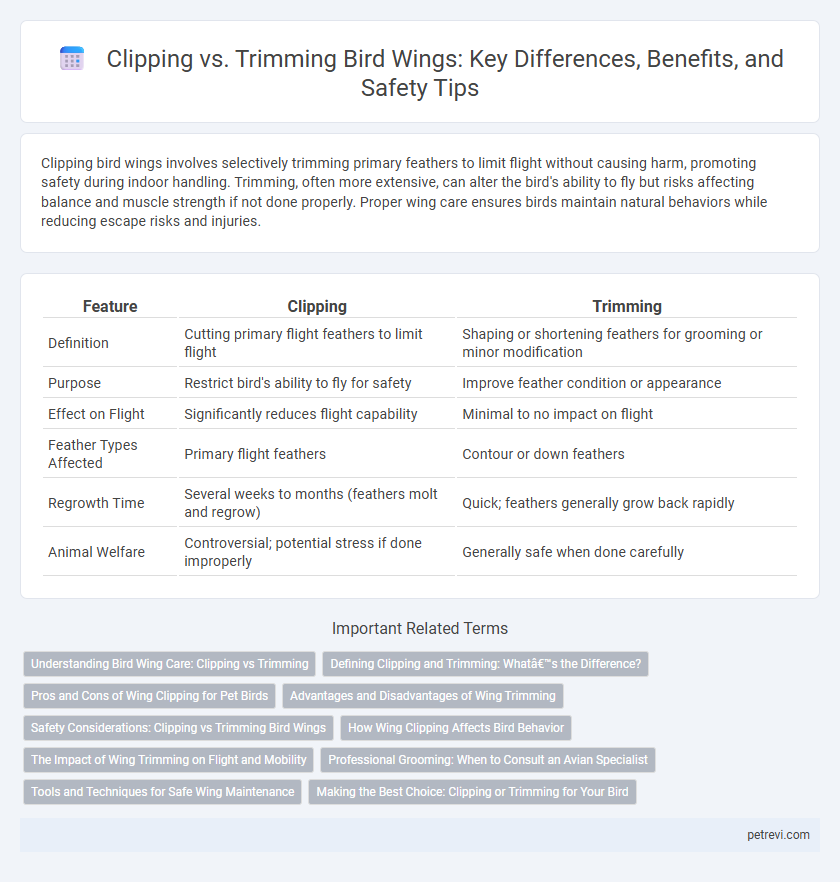Clipping bird wings involves selectively trimming primary feathers to limit flight without causing harm, promoting safety during indoor handling. Trimming, often more extensive, can alter the bird's ability to fly but risks affecting balance and muscle strength if not done properly. Proper wing care ensures birds maintain natural behaviors while reducing escape risks and injuries.
Table of Comparison
| Feature | Clipping | Trimming |
|---|---|---|
| Definition | Cutting primary flight feathers to limit flight | Shaping or shortening feathers for grooming or minor modification |
| Purpose | Restrict bird's ability to fly for safety | Improve feather condition or appearance |
| Effect on Flight | Significantly reduces flight capability | Minimal to no impact on flight |
| Feather Types Affected | Primary flight feathers | Contour or down feathers |
| Regrowth Time | Several weeks to months (feathers molt and regrow) | Quick; feathers generally grow back rapidly |
| Animal Welfare | Controversial; potential stress if done improperly | Generally safe when done carefully |
Understanding Bird Wing Care: Clipping vs Trimming
Bird wing care involves two main techniques: clipping and trimming, both aimed at managing flight ability. Clipping cuts specific flight feathers to limit flight for safety and control, while trimming reshapes the feathers for smoother edges and better feather health. Proper understanding of each method ensures balanced wing maintenance, supporting the bird's well-being and preventing injury.
Defining Clipping and Trimming: What’s the Difference?
Clipping bird wings involves selectively cutting specific primary flight feathers to reduce a bird's ability to fly, helping to keep the bird safe indoors or during supervised outdoor time. Trimming, however, may include a broader grooming approach, such as shortening nails or beak along with wing feather modification, without necessarily targeting flight feathers alone. Understanding the distinction between clipping as a precise flight-limiting technique and trimming as general maintenance is crucial for responsible avian care and preventing stress or injury.
Pros and Cons of Wing Clipping for Pet Birds
Wing clipping for pet birds involves trimming the primary flight feathers to reduce their flying ability, which helps prevent injury and escape. The pros include enhanced safety by limiting flight in hazardous environments and easier handling during training, while the cons involve potential stress, discomfort, and reduced exercise leading to muscle atrophy. Properly performed wing clipping by an experienced avian vet or groomer minimizes risks but requires regular maintenance as feathers molt and regrow.
Advantages and Disadvantages of Wing Trimming
Wing trimming for birds offers advantages such as improved safety by preventing long-distance flight and reducing the risk of injury or escape. However, disadvantages include potential stress or discomfort for the bird, reduced exercise opportunities, and impaired natural behaviors like flying and gliding. Proper trimming techniques and regular monitoring are essential to balance safety with the bird's physical and psychological well-being.
Safety Considerations: Clipping vs Trimming Bird Wings
Clipping bird wings involves selectively cutting primary flight feathers to limit flight ability while maintaining balance and muscle strength, reducing the risk of injury during indoor flights. Trimming, a more extensive feather reduction, can impair a bird's natural flight mechanics, potentially causing stress or harm if not done by experienced handlers. Prioritizing professional guidance ensures wing modifications protect the bird's safety without compromising overall well-being.
How Wing Clipping Affects Bird Behavior
Wing clipping restricts a bird's ability to fly by partially trimming the primary flight feathers, which can lead to reduced mobility and increased dependence on their owner for safety. This limitation often causes changes in behavior such as increased vocalization, stress, and attempts to escape or fly despite clipped wings. Birds with clipped wings may also develop stronger leg muscles from increased hopping and climbing, but their natural instincts and overall mental stimulation can be negatively impacted.
The Impact of Wing Trimming on Flight and Mobility
Wing trimming in birds reduces flight capabilities by shortening primary feathers, which limits lift and maneuverability, thereby preventing escape without causing injury. This practice enhances safety in domestic settings by minimizing risks associated with uncontrolled flight while maintaining sufficient mobility for balance and wing use. Proper trimming requires knowledgeable handling to avoid impairing a bird's natural behaviors and overall well-being.
Professional Grooming: When to Consult an Avian Specialist
Professional grooming for bird wings requires consulting an avian specialist to determine whether clipping or trimming is appropriate based on species, age, and behavior. Experts assess wing condition and flight needs to minimize stress and ensure the bird's safety during handling. Regular visits to a certified avian groomer prevent potential wing damage and promote optimal feather health.
Tools and Techniques for Safe Wing Maintenance
Clipping bird wings requires specialized scissors or clippers designed with rounded edges to prevent injury to the delicate feathers and skin. Trimming involves using fine, sharp grooming scissors to selectively shorten feathers without compromising flight balance, often guided by an avian veterinarian or experienced bird handler. Proper restraint, knowledge of feather anatomy, and sterile tools are essential to ensure safe and effective wing maintenance, minimizing stress or harm to the bird.
Making the Best Choice: Clipping or Trimming for Your Bird
Choosing between clipping and trimming bird wings depends on the bird's species, age, and activity level to ensure safety without hindering natural behaviors. Wing clipping involves selectively cutting primary flight feathers to reduce flight capability temporarily, offering controlled mobility and preventing escapes. Trimming maintains more feather length, allowing limited flight while minimizing risk, making it ideal for birds requiring partial freedom and enrichment.
Clipping vs Trimming for Bird wings Infographic

 petrevi.com
petrevi.com